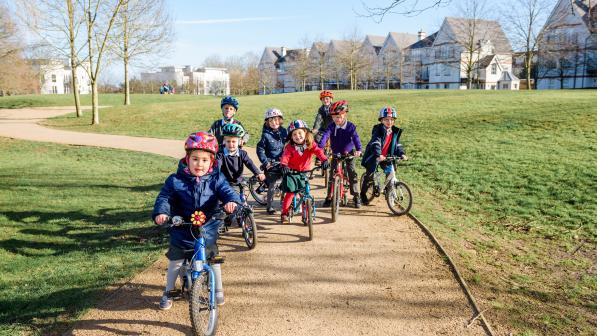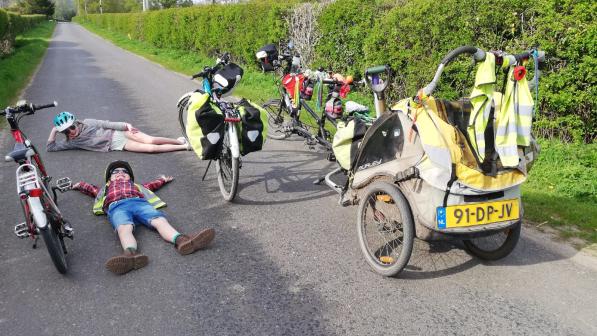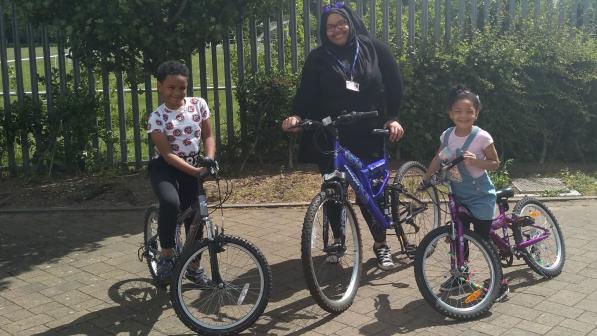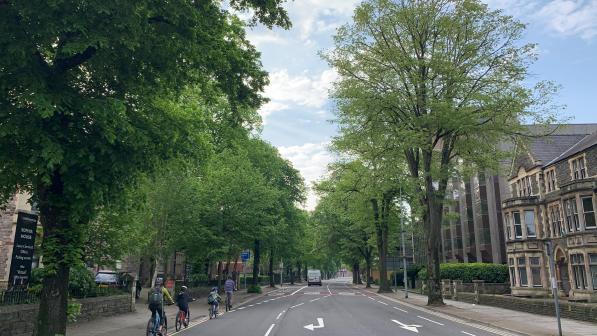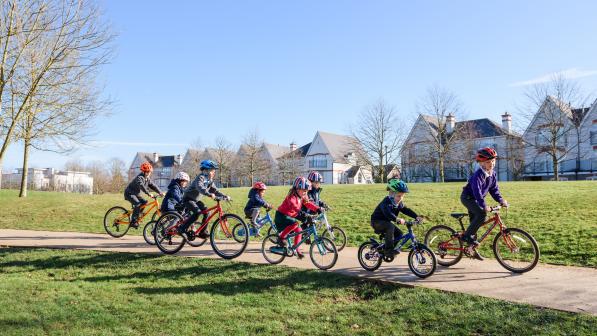Back to school after lockdown: Cycling UK’s guide to cycling for the school run

With children gradually returning to school following months of coronavirus lockdown, many parents and guardians are understandably concerned about social distancing on the school run.
For some, it simply can’t be back to normal, especially if the journey used to involve piling onto school buses and public transport, or taking taxis.
Others may have been enthused by cycling during lockdown, and want to explore the possibilities during term-time too, but are worried about rising traffic levels.
Cycling or walking for the school run are the perfect choice for many people, and it’s not just Cycling UK saying that:
- In England, the Department for Education’s guidance on transport to school for the autumn term says that schools and colleges should "encourage parents, staff and pupils to walk or cycle to school where it is safe and appropriate to do so." It adds that: "At a national level, at least 50% of journeys to school of 2 miles or less, and which are currently undertaken by public bus, need to switch to cycling and walking in order to make capacity available for those with longer journeys."
- In its guidance on school transport, Transport for Wales asks parents to "consider walking or cycling to school where possible".
- The Scottish Government's advice on preparing for the new school term says: "As far as it is safe to do so, the use of active travel routes by parents/carers, staff and children and young people should be encouraged. Walking and cycling, scooting, wheeling etc should be strongly encouraged."
- Northern Ireland's Department of Education's FAQs on returning to school, strongly encourages parents, children and young people to travel actively, only using the home to school transport service where no alternative is available.
Why cycle for the school run?
It’s never been more important to make conditions welcoming, fit for purpose and safe for children riding between home and school. Why?
- It’s much easier to control social distancing on a cycle than on public transport and school buses. See our regularly updated coronavirus Q&A for more on cycling during the epidemic.
- If a school is not just round the corner, children will get there more quickly by cycling than by walking.
- More cycling and fewer car trips mean that children who suffer from respiratory conditions will benefit from cleaner air. Lockdown significantly reduced pollution, and regressing to pre-coronavirus levels is in nobody’s interests, especially for a child with asthma or other serious breathing problems.
- Cycling contributes to fitness and maintaining a healthy weight. Figures on unhealthy weight among children are alarming: in England, for example, over a fifth of those in Reception, and over a third in Year 6 were classified as either overweight or obese in 2018/19.
- Cycling also helps improve concentration in the classroom, familiarises children with their locality, and builds up roadcraft, life skills, independence and a sense of achievement.
- Most children enjoy riding their bikes, and lots of families have loved cycling together during lockdown. Why not keep the enthusiasm up through term-time?
What can parents do?
- Unless you’re fully confident that your child is able to ride safely on their own, accompany them and teach them along the way. If you’re working at home, you may appreciate the time with them and the outdoor exercise.
- Check that your bikes are roadworthy – if necessary, take them to a bike shop/qualified mechanic.
- It may be a while before group or face-to-face cycle training is widely available again, but there are instructive, online resources to watch in the meantime:
- Cycling UK’s Start Cycling and Go Cycling webpages are packed with tips and videos for beginners and more experienced cyclists on riding in traffic, family cycling, fixing bikes and much more.
- Our regularly updated Q&A on minimising the risks to yourself and others while cycling during the coronavirus outbreak.
- Bikeability guidance on cycling during lockdown (see ‘Improving children’s cycling skills’ below for more about Bikeability cycle training). In future, grab any offers of Bikeability training offered to your children at school and, if your own cycling skills are a little rusty, take a course yourself.
- Talk to the school about any facilities that are missing, or need improving, and find out if they’re in touch with the council about any road safety issue. If they’re not (or haven’t the time), contact them yourself. Our Space for Social Distancing campaign may be a useful lever for you.
- Now that central government is strongly encouraging cycling for the school run, Cycling UK would be both surprised and disappointed to see any school actively discouraging cycling, issuing anti-cycling statements and letters, or obstructing cycling in any way. But, if you need to persuade a school to rethink, we have some ideas.
What can local authorities do?
- In conjunction with school communities, identify hostile conditions and blackspots that put parents and schools off encouraging children to cycle.
- Take urgent steps to deal with the problems you've jointly identified, making good use of any central government money, including the funding available to facilitate social distancing through walking and cycling (e.g. for widening pavements, ‘pop-up’ bike lanes etc.). See below for more on making streets cycle-friendly.
- Whilst working on measures to improve a child’s wider journey by foot of bike, look into introducing ‘school streets’, i.e. restricting motor traffic along roads outside schools at drop-off and pick-up times.
- Ensure officers have the knowledge and resources to advise schools and parents on promoting cycling and catering for it.
- Support schools proactively to develop or review their School Travel Plans.
What can schools do?
Coronavirus is, and will go on making many and varied demands on schools for some time, and what to do about the school run will only be one of them. Here are some steps to help (not necessarily in this order):
- Take a whole-school, concerted approach to catering for cycling and walking. By engaging everyone - head teachers, teachers, other staff, parents, PTAs, governors and children – embedding active travel into a school’s culture is more likely to succeed.
- Include advice on driving safely round children in all new drop-off/pick-up guidance.
- Check your cycle racks. Ideally, they should be secure, covered, in sight to ward off vandalism and theft, able to support small bike frames, in the form of upturned ‘U’s (not slots in concrete) and of sufficient quantity (you may need more). Your local authority may be able to help with advice and a budget. You will also need to make arrangements to have them properly sanitised.
- Survey the school community to find out exactly what everyone needs to cycle there, what the obstacles are, and the extent of potential demand. This should cover both the facilities on the premises and the roads outside.
- Talk to your local authority about problems children encounter on the road network. As part of the project to improve your pupils' wider journeys to school, ask them to introduce a ‘school street’ outside (i.e. restricting both through and school motor traffic at drop-off and pick-up times). This helps deal with crowding round school gates, inadvisable at any time for road safety reasons, but nowadays also an issue for social distancing.
- Set up a committee dedicated to developing and implementing an action plan for active travel.
- Appoint ‘cycling champions’ (adult and child) to keep the momentum going.
- Review the school’s Travel Plan and make sure cycling and walking are at its core.
- Talk to your local authority about free ‘Bikeability’ training for all children, but don’t try to stop ‘unqualified’ pupils from cycling, as some of them will probably have to wait a while for a face-to-face course. Many need to cycle now. (See below for more on improving children's cycling skills).
- When it’s safe to do so, invite qualified mechanics to offer ‘Dr Bike’ sessions to help make sure children’s bikes are roadworthy.
- Celebrate cycling with events, themed lessons, bike clubs etc (again, when it’s safe).
- Actively encourage cycling and walking in all relevant policies and guidance.
Resolving fears and barriers
Fearing for children’s safety on the roads is entirely understandable, but it may be of some comfort to know that the health advantages of cycling outweigh the risks by far. In fact, cycling often looks more dangerous than it actually is.
Also, cycles do very little harm to other road users (well over 90% of pedestrians who are hurt in collisions, for instance, are hit by motor vehicles). What’s more, if cycling substitutes for car trips, road conditions grow safer, safer-feeling and more pleasant for everyone.
That said, cycling is not risk-free and it’s this thought that puts some parents and schools off actively encouraging children to do it.
Typically, they worry about children’s cycling skills and conduct, poor or hazardous road infrastructure, and bad driving.
The following looks at these common fears and barriers, and tried and trusted ways to help resolve them.
Improving children’s cycling skills
- As mentioned, one of the most constructive ways of helping children to ride safely is to give them free cycle training, e.g. a ‘Bikeability’ course, or one that also meets the national standard for cycle training. This offers children practical skills for riding on today’s roads, including techniques such as looking and anticipating the movements of drivers and other road users. The training is effective, well-researched and is known to give many parents and teachers peace of mind. It may be quite a while, though, before face-to-face instruction is available again, but it’ll be well worth the wait. For now, see Bikeability's advice on cycling during lockdown.
- Riding with your child/children to school and teaching them along the way may help too. (Note that many cycling instructors offer Bikeability to adults needing a refresher too).
- See Cycling UK’s online advice on cycling safely - Start Cycling and Go Cycling pages - plus our coronavirus specific Q&A.
Making streets cycle-friendly
If there haven’t been any child-friendly routes to school so far in your area, things may well be looking up.
With government backing, many councils are currently installing temporary ‘pop-up’ cycle lanes that separate cycles from other traffic.
Apart from helping key workers commute to work by cycle, and making it easier for everyone to observe social distancing rules, routes that are free of motor traffic are of enormous value to children on the way to and from school.
Cycling UK has been campaigning for safe space for some time as have many local people, and we’ve recently launched our safe space for social distancing campaign, together with a map showing local progress.
Obviously, we want to see cycle-friendly infrastructure proliferate beyond the coronavirus crisis, and for all worthwhile improvements to become permanent.
There are all sorts of measures that can help: new cycle lanes and crossing points, revamping junctions, restricting motor traffic on school streets at drop-off and pick up times, and reducing speed limits to 20 mph on local streets where children (or indeed anyone of any age) are likely to cycle and walk, or want to cycle and walk. Local councillors and their staff need to know how important this is to schools.
Educating drivers
While segregated space for cycling and other cycle-friendly measures help protect cyclists, young and old, bad driving needs to be eradicated altogether.
With many schools reissuing their drop-off guidelines or writing new ones, along with more young cyclists about, it makes sense to include advice on driving round cyclists safely and considerately.
The police may be willing to help with the messaging and, if need be, enforcement, should any driver break the law.
See Cycling UK’s guidance on overtaking and opening car doors and our tips for drivers.
Finally
Whatever your role in a school community or local authority, it’s time to pull out all the stops to help children cycle between home and school. We hope this guide helps, and wish you good luck.
